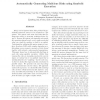Free Online Productivity Tools
i2Speak
i2Symbol
i2OCR
iTex2Img
iWeb2Print
iWeb2Shot
i2Type
iPdf2Split
iPdf2Merge
i2Bopomofo
i2Arabic
i2Style
i2Image
i2PDF
iLatex2Rtf
Sci2ools
SP
2006
IEEE
2006
IEEE
Automatically Generating Malicious Disks using Symbolic Execution
Many current systems allow data produced by potentially malicious sources to be mounted as a file system. File system code must check this data for dangerous values or invariant violations before using it. Because file system code typically runs inside the operating system kernel, even a single unchecked value can crash the machine or lead to an exploit. Unfortunately, validating file system images is complex: they form DAGs with complex dependency relationships across massive amounts of data bound together with intricate, undocumented assumptions. This paper shows how to automatically find bugs in such code using symbolic execution. Rather than running the code on manually-constructed concrete input, we instead run it on symbolic input that is initially allowed to be “anything.” As the code runs, it observes (tests) this input and thus constrains its possible values. We generate test cases by solving these constraints for concrete values. The approach works well in practice: ...
Code | File System Code | Security Privacy | SP 2006 | file Systems |
| Added | 12 Jun 2010 |
| Updated | 12 Jun 2010 |
| Type | Conference |
| Year | 2006 |
| Where | SP |
| Authors | Junfeng Yang, Can Sar, Paul Twohey, Cristian Cadar, Dawson R. Engler |
Comments (0)

